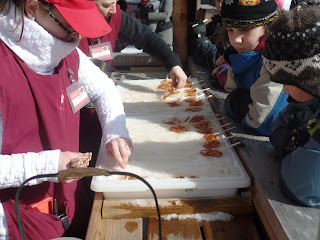For more
information about Susan Calder's books, or to purchase visit her Books We Love Author Page.
This winter, rather than escape for a week on a warm beach I went to Ottawa, Canada, one of the coldest national capital cities in the world.
 |
| On December 27, 2017, Ottawa, with temperatures of -29 degrees Celsius, was the world's coldest capital city. |
The draw was my son, his wife and their six-month old daughter. Fortunately, Ottawa weather co-operated for the long family weekend in February. With temperatures hovering around the freezing mark, we were able to get out and enjoy the city's annual festival, Winterlude.
 |
| Winterlude - ice carving demonstration |
While the rest of us watched the action, my son skated on the Rideau Canal, the world's largest skating rink.
We continued to Parliament Hill, which features a hockey rink set up for Canada's 150th birthday.
 |
| Winter isn't cold when you're bundled-up |
The next day we drove to a maple sugar farm outside of Ottawa. It was a few days early for the sap to run, but we enjoyed the taffy pull on snow and pancake brunch.
The Rideau Canal Skateway runs a distance of 7.8 km from Dow's Lake to downtown Ottawa, enabling energetic commuters to skate to work. On day three we walked from my son's house to the lake. The next day the city closed the whole Skateway for the season due to the increasingly mild temperatures.
Rain started that night and continued for two days. My husband and I escaped indoors with friends at the Museum of Science and Technology. Fun activities included steam trains, a Crazy Kitchen with a cock-eyed design that left me feeling queasy, and a computer game exhibit with holograph costumes.
The exhibit reminded me that many computer games take players through a story and developing game scripts is an up-and-coming field for writers. Perhaps my young granddaughter will one day combine math and writing skills and choose this intriguing career.
The winter holiday made me curious about where Ottawa ranks on the list of cold national capital cities. My Internet source, Worldatlas, rates Canada's capital #7, based on average annual daily (24 hour) temperature. Ottawa lost its 3rd place status after the breakup of the Soviet Union, when Moscow ceded second place to Astana, Kazakhstan.
 |
| Moscow, Russia, the world's third coldest national capital city. |
All of the world's coldest capital cities are in the Northern hemisphere. The southern capitals don't reach far enough south. The world's southernmost capital is Wellington, New Zealand. Due to water currents, the northernmost capital, Reykjavik, Iceland, only makes #5 on the list.
 |
| Reykjavik, Iceland |
And the winner (or should we say loser?) of the coldest capital city award is --
Ulaan-Baatar, Mongolia, with an average annual temperature of -1.3 degrees Celsius (29.7 F) and below zero temperatures for five months of the year.
 |
| Ulaan-Baatar, Mongolia |
Here's the complete list of the world's top seven coldest capital cities.
1. Ulaan-Baatar, largest city in Mongolia. In January and February, the coldest months, temperatures range between -15 C and -40 C.
2. Astana, Kazakhstan. The climate is extreme. In summer temperatures occasionally reach 35 C (95 F) while winter temperatures fall to -35 C (-22 to -31 F) between mid-December and early March. Annual average is 3.5 C.
 |
| Astana - futuristic towers rise abruptly from the steppe |
3. Moscow, Russia, 'enjoys' long, cold winters from mid-November to late March. Summer temperatures range from 10-35 C (50-95 F). Average annual daily temperature 4.1 C (39.4 F).
4. Helsinki, Finland (4.5 C / 40.1 F). The average winter temperature in the coldest months, January and February, is -5 C. The Baltic Sea and North Atlantic Current moderate temperatures, keeping the city somewhat warmer in winter and cooler in summer.
5. Reykjavik, Iceland (4.6 C / 40.3 F) is also moderated by the North Atlantic Current, an extension of the Gulf Stream.
6. Tallinn, Estonia (4.8 C / 40.6 F), the capital and largest city of Estonia, is called 'the Silicon Valley of Europe.' Skype got its start here. Tallinn's location on the Gulf of Finland moderates its climate.
7. Ottawa, Canada, average annual temperature 5.5 C / 41.9 F. Canada's fourth largest city, with the country's most educated population and highest standard of living. Winters are snowy and cold; summers warm and humid. In July the average daily high is 26.6 C (80 F). Despite being #7 on the cold capitals list, my friends in Ottawa wouldn't live there without air conditioning.
But now it's March, the coldest days of winter are past and Ottawa looks forward to its spring tulip festival, when millions of tulips bloom through Canada's capital city. Every year The Netherlands sends tulip bulbs for the festival as thanks to Ottawa for housing the Dutch royal family during World War II.
.






























